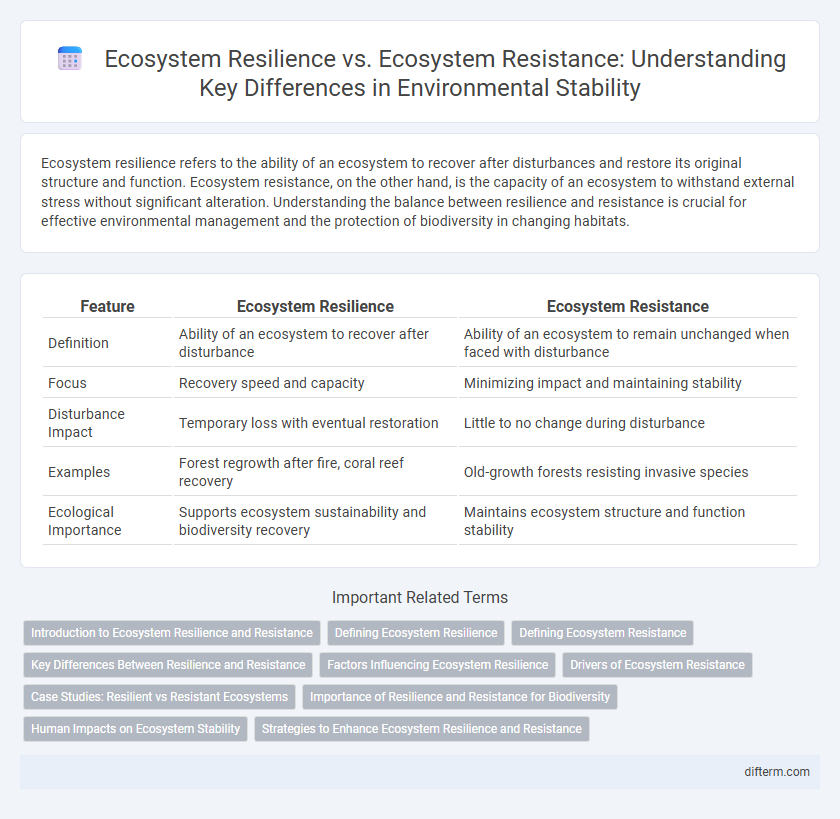Ecosystem resilience refers to the ability of an ecosystem to recover after disturbances and restore its original structure and function. Ecosystem resistance, on the other hand, is the capacity of an ecosystem to withstand external stress without significant alteration. Understanding the balance between resilience and resistance is crucial for effective environmental management and the protection of biodiversity in changing habitats.
Table of Comparison
| Feature | Ecosystem Resilience | Ecosystem Resistance |
|---|---|---|
| Definition | Ability of an ecosystem to recover after disturbance | Ability of an ecosystem to remain unchanged when faced with disturbance |
| Focus | Recovery speed and capacity | Minimizing impact and maintaining stability |
| Disturbance Impact | Temporary loss with eventual restoration | Little to no change during disturbance |
| Examples | Forest regrowth after fire, coral reef recovery | Old-growth forests resisting invasive species |
| Ecological Importance | Supports ecosystem sustainability and biodiversity recovery | Maintains ecosystem structure and function stability |
Introduction to Ecosystem Resilience and Resistance
Ecosystem resilience refers to the capacity of an ecosystem to recover from disturbances and return to its original state, while ecosystem resistance describes the ability to withstand disturbances without significant change. Resilience involves adaptive processes that restore ecosystem functions after disruptions, whereas resistance minimizes the impact intensity during stress events. Understanding the balance between resilience and resistance is crucial for effective ecosystem management and conservation strategies under environmental stressors.
Defining Ecosystem Resilience
Ecosystem resilience refers to the capacity of an ecosystem to absorb disturbances and reorganize while undergoing change, maintaining essential functions, structures, and feedbacks. Unlike ecosystem resistance, which measures the ability to withstand disturbance without altering, resilience emphasizes recovery and adaptation after disruption. Key indicators of resilience include biodiversity levels, habitat connectivity, and the presence of keystone species that facilitate ecosystem stability.
Defining Ecosystem Resistance
Ecosystem resistance refers to the ability of an ecosystem to remain unchanged when subjected to external stress or disturbances, maintaining its structure and functions. High resistance ecosystems quickly absorb shocks from events such as droughts, fires, or pollution without significant alterations in biomass or species composition. This property is crucial for sustaining biodiversity and ecosystem services under increasing environmental variability.
Key Differences Between Resilience and Resistance
Ecosystem resilience refers to the ability of an ecosystem to recover after disturbances such as wildfires or floods, while ecosystem resistance indicates how well an ecosystem can withstand these disturbances without significant change. Resilience emphasizes recovery and adaptation processes, involving species regeneration and nutrient cycling, whereas resistance highlights stability and persistence under stress. Understanding these differences is crucial for effective conservation strategies and managing biodiversity under climate change impacts.
Factors Influencing Ecosystem Resilience
Ecosystem resilience depends on biodiversity, genetic variability, and the complexity of species interactions, which enable recovery from disturbances. Soil health, climate stability, and nutrient cycling also play vital roles in maintaining resilience by supporting adaptive capacity. Human activities and habitat fragmentation can reduce resilience by weakening these natural processes and connectivity.
Drivers of Ecosystem Resistance
Drivers of ecosystem resistance primarily include species diversity, genetic variability, and habitat complexity, which enable ecosystems to withstand disturbances without significant functional change. Abiotic factors such as climate stability, soil composition, and hydrological conditions also play crucial roles in maintaining ecosystem resistance. Human activities like deforestation and pollution can weaken these drivers, reducing an ecosystem's ability to resist environmental stresses.
Case Studies: Resilient vs Resistant Ecosystems
Case studies of ecosystem resilience versus resistance highlight distinct recovery patterns following disturbances, with resilient ecosystems rapidly restoring functionality and biodiversity, while resistant ecosystems maintain stability by minimizing change. For example, the Yellowstone National Park exhibits resilience through its forest regeneration after wildfires, whereas certain coral reefs demonstrate resistance by withstanding bleaching events without significant species loss. These comparative analyses emphasize the importance of adaptive management strategies that support either resilience or resistance based on specific environmental conditions and stressors.
Importance of Resilience and Resistance for Biodiversity
Ecosystem resilience enables recovery from disturbances by maintaining key functions and supporting species diversity, ensuring long-term biodiversity stability. Ecosystem resistance minimizes the impact of environmental stressors, preserving habitat conditions and preventing biodiversity loss. Together, resilience and resistance are critical for sustaining complex ecological networks and enhancing adaptive capacity amid climate change.
Human Impacts on Ecosystem Stability
Ecosystem resilience refers to an ecosystem's ability to recover from disturbances caused by human activities such as deforestation, pollution, and climate change, while ecosystem resistance is its capacity to remain unchanged despite these impacts. Human-induced stressors reduce resistance by destabilizing species composition and nutrient cycles, but some ecosystems exhibit high resilience by adapting through ecological processes and species interactions. Understanding the balance between resilience and resistance is critical for developing conservation strategies that mitigate environmental degradation and promote long-term ecosystem stability.
Strategies to Enhance Ecosystem Resilience and Resistance
Enhancing ecosystem resilience involves strategies such as promoting biodiversity, restoring native habitats, and implementing adaptive management practices to help ecosystems recover from disturbances. Strengthening ecosystem resistance focuses on reducing stressors like pollution and invasive species, as well as maintaining environmental conditions that prevent ecosystem degradation. Integrating both approaches through conservation efforts and sustainable resource management ensures ecosystems can withstand and bounce back from environmental changes effectively.
ecosystem resilience vs ecosystem resistance Infographic

 difterm.com
difterm.com